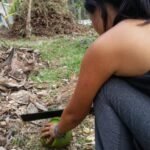I’ve always been jealous of people who can climb coconut trees. Growing up in the Philippines, I loved the easy access to cheap coconuts. I’ve often sat and watched people climb up the trees with ease, grabbed a coconut from the top, and slide back down like a boss.
In tropical and humid countries, coconuts are the fruits of choice. They are known for their many uses as seen in this awesome and catchy song in Moana:
On a hot and humid day, thirsty? We drink the coconut juice. Hungry? We eat the meat inside. The leaves are used to fire, basket-weaving, shade, and more! The trees are easily accessible, can be seen everywhere on the streets. I’ve always wanted to climb one. The problem: the coconuts are super high up in the air. Since there are no branches to climb up on, people rely on pure arm and leg strength. /ugh/
Being a less than capable climber, I mostly admire these coconut climbers from afar. While traveling in Central America, locals showed us new methods to help the coconut harvest process safer and go faster, and can be learned by newbies. Yes! The group of Italians who stayed with us were too smart to try something like this and had only watched us from the hut. My boyfriend, Cuong, who has always been more physically fit than me, climbed first on the tree about fifty feet in the air.
How it works: Using two rope loops, wrap them around the tree. One rope loops around your thigh, and the other rope is used to step on. You can lever yourself upwards by shifting the ropes up. See a video of coconut climbing in action here.
My turn. Still in my flip flops, I decided to give it a try. Skeptical of my abilities to go all the way up, I was hoping to maybe climb a few feet. Before I knew it, I was already a fourth of the way up the tree. Wow, it was easier than I thought. The ropes dug into my thighs and the tree scraped against my arms and and legs, but it was do-able! I decided to keep going, despite the lack of proper shoes.

Two-thirds of the way up, the tree curved to the side, the ropes didn’t have enough friction to grab onto the tree, and slid loose. I lost my footing. My heart jumped out of my chest.
I was so scared that for the next five minutes, I hugged and cursed myself for climbing so far up in the first place. One fall like that could definitely break a bone. After what felt like an eternity of panic, I realized that no one is going to be able to help me. I have to get out of this mess on my own. I decided to keep climbing up (since I didn’t know how to get down and that was a problem for future Winta).
The top of the coconut tree had dry fibery leaves, which made it difficult for the ropes to grab on. The coconut was more difficult to pick than I thought. I had to twist it a dozen times before it broke and fell to the ground. My first coconut picked from the tree.

As with any cat that climbs a tree and can’t get down, I looked at the ground faaaarr below me. I realized I didn’t know how to get back down. Great, fifty feet in the air and I’m experimenting on ways to pull the ropes and lever back down. After a series of trial and error, I was finally able to shimmy myself back down.
Here are a couple of celebratory pictures of my difficult climb:
I should also mention that both our climbs took about 20-30 minutes, and the locals probably take 5 minutes to go through the whole process. I imagine that they were highly amused by our determination through this ordeal. Despite my incredible thirst, I spent 15 minutes clumsily cutting open my coconut and drank the sweet, sweet reward.
I’m quite proud of this day, almost falling off a coconut tree, but reaching my goal. I came out with only a couple of scratches, aches, and bruises, but I had learned something new: that it was all possible. Perhaps, in the far future, I will climb for coconuts again.
Thanks for reading!! I would love to hear your thoughts on my dangerous heist in comments below. <3
























